Dry Needling


Dr. Jonathan Evans
PT, DPT, CMTPT, VRC, PDNC
Chief Executive Officer, Orthopedic & Vestibular Physical Therapist
Dry needling helps alleviate local and referred trigger point pain. A trigger point is a hyper-irritable spot in the muscle that can be locally painful and/or refer to different regions of the body.
The treatment involves inserting a thin needle into trigger points within tight muscles, without injecting any substance. Penetration of a normal muscle is painless due to the small size of needles used; however, a shortened, supersensitive muscle will ‘grasp’ the needle which will result in what can be described as a cramping sensation. The result is a reflex relaxation and/or lengthening response. This reflex is a positive indicator that the dry needling is effectively reducing the tension caused by the trigger point. A dull soreness following the dry needling is typical for 1-2 days.
Dry needling is similar to acupuncture, but not the same. Acupuncture is based on meridian lines of the body and is derived from Eastern medicine. Needles are inserted superficially and left in for an extended period of time. Even though we believe acupuncture is effective, we do not provide it in our office. In dry needling, the needle is inserted into a trigger point, manipulated, and then removed. Dry needling is a quick and very effective technique in reducing tight and painful muscles. Tight muscles across a joint will increase joint pressure, cause malalignment, and pain in the joint and/or refer elsewhere. Dry needling can decrease pain, reduce muscle tension, improve strength and range of motion.
